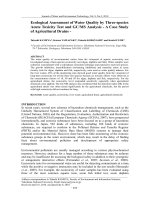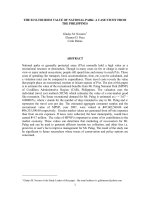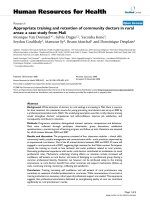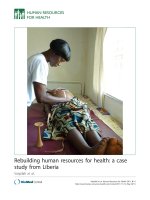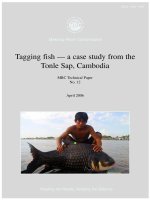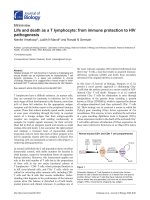Geosite and Geomorphosite Assessment as a Tool for Geoconservation and Geotourism Purposes: a Case Study from Vizovická vrchovina Highland (Eastern Part of the Czech Republic)
Bạn đang xem bản rút gọn của tài liệu. Xem và tải ngay bản đầy đủ của tài liệu tại đây (1020.33 KB, 11 trang )
See discussions, stats, and author profiles for this publication at: />
Geosite and Geomorphosite Assessment as a Tool for Geoconservation and
Geotourism Purposes: a Case Study from Vizovická vrchovina Highland
(Eastern Part of the Czech Republic)
Article in Geoheritage · January 2016
DOI: 10.1007/s12371-015-0143-2
CITATIONS
READS
26
546
2 authors:
Lucie Kubalíková
Karel Kirchner
Institute of Geonics AS CR
Institute of Geonics AS CR
21 PUBLICATIONS 95 CITATIONS
112 PUBLICATIONS 345 CITATIONS
SEE PROFILE
SEE PROFILE
Some of the authors of this publication are also working on these related projects:
Disaster management support scenarios using geoinformation technologies View project
The environmental impacts of anthropogenic activities on the landscape and its components - part of Institucional project - Institute of Geonics, Czech Academy of
Sciences View project
All content following this page was uploaded by Karel Kirchner on 14 March 2018.
The user has requested enhancement of the downloaded file.
Geoheritage (2016) 8:5–14
DOI 10.1007/s12371-015-0143-2
ORIGINAL ARTICLE
Geosite and Geomorphosite Assessment as a Tool
for Geoconservation and Geotourism Purposes: a Case Study
from Vizovická vrchovina Highland (Eastern
Part of the Czech Republic)
Lucie Kubalíková & Karel Kirchner
Received: 31 July 2014 / Accepted: 25 January 2015 / Published online: 5 February 2015
# The European Association for Conservation of the Geological Heritage 2015
Abstract The geoheritage of the Czech Republic presents a
basis for geoconservation and geotourism activities which
have a long tradition in the region. Sites of geological and
geomorphological interest have been appreciated for a long
time, and from the nineteenth century, some have been declared as protected. The first official list of protected sites
was created during the 1930s, and in 1956, the first law on
nature conservation was approved. Today, nature conservation
is covered by the Act 114/1992 Coll. that enables landscapes,
karst features, minerals, and fossils to be protected as well as
the establishment of protected areas. In addition, there are
many other geoconservation assessments, e.g., the database
of the geological sites or the network of the national geoparks.
In the National Parks, Protected Landscape Areas or geoparks,
the promotion of geosites and geomorphosites is well developed. However, outside these areas, the promotion and use of
sites for geotourism purposes is relatively poor, although it is
obvious that they can represent a source for geotourism activities that can foster local economic development. For finding
out which sites are suitable for geotourism development, a
simple method was proposed and the selected sites of the
Vizovická vrchovina Highland (Czech Republic) were
assessed. Based on this, strengths, weaknesses, opportunities
and threats were identified. The assessment and the following
analysis of the area can serve as a basis for the future proposals
for geotourist use of the sites.
L. Kubalíková (*) : K. Kirchner
Institute of Geonics, Academy of Sciences of the Czech Republic,
v.v.i. Branch Brno, Drobného 28, 602 00 Brno, Czech Republic
e-mail:
K. Kirchner
e-mail:
Keywords Geotourism . Geoconservation . Geosite and
geomorphosite assessment . Vizovická vrchovina Highland .
SWOT analysis
Introduction
Visiting natural sites that are important from the geological or
geomorphological point of view has been practised for a long
time (Migoń 2009; Dowling 2013), and today, the number of
people who are looking for the deeper experience of the visited site or area is growing; these visitors want to know more
about the site or area and related issues (in the case of the
geosites and geomorphosites, this information should cover
not only Earth sciences but also historical, archaeological,
ecological or artistic aspects of the site), and in the case that
an area or a site is protected, they wish to understand why. Of
course, they also expect a good quality of support services
such as safe and well-marked paths, information services
(leaflets, information panels, guided tours etc.), accommodation, transport facilities and catering and they expect that there
will be an opportunity to buy products that are typical for the
area, whether it is a local food, drink or handicraft product.
These factors contribute to the development of sustainable
forms of tourism (especially geotourism), and they can help
the economic development of the rural areas (Pásková 2012).
There are several definitions of geotourism; probably, the
most comprehensive is the definition of Dowling (2013):
Geotourism is sustainable tourism with a primary focus on
experiencing the Earth’s geologic features in a way that fosters
environmental and cultural understanding, appreciation and
conservation and is locally beneficial. Geotourism product
6
protects, communicates and promotes geoheritage, helps build
communities and works with a wide range of different people.
It is obvious that geology and geomorphology form an
essential resource for geotourism activities. Reynard et al.
(2003) and Reynard (2008) analysed the relationship between
geomorphology and tourism: geomorphology may be a tourist
resource as part of the primary or original offer (geomorphological site as an attraction or geomorphological site as a support for tourist activity) and a secondary or derived offer, when
tourist infrastructures (e.g. didactic trails), instruments (e.g.
educational booklets) or services (e.g. guided tours) are developed for the effective use of the original offer. Gray (2013)
also stated that geodiversity is of great value for geotouristic
and geoeducational activities—it is one of the functions of
geodiversity; however, it is evident that geodiversity as a
whole cannot be used for geotourism purposes; and tourist
use of geodiversity is generally made through the exploitation
of geosites and geomorphosites (Pralong 2003; Pralong and
Reynard 2005). The cultural issues also have a big influence
on the geotourism development (Panizza and Piacente 2008)
as they often increase the attractiveness of the geosites and
geomorphosites.
Past and Present of Geoconservation and Geotourism
in the Czech Republic
The Czech Republic is geologically and geomorphologically
very diverse; within its area, nearly all the geological periods
and a considerable number of the landforms types can be
traced (Budil et al. 2012). Already in the nineteenth century,
some geosites and geomorphosites were frequently visited
and they became traditional touristic destinations, e. g.
Pravčická brána, a natural sandstone arch in the Czech
Switzerland National Park in northern Bohemia (Cílek 2010).
The first attempts to protect nature in the Czech countries
were linked to the protection of forests, wood and game, and
they appeared already during the Middle Ages. Later, in the
nineteenth century (the period of the Romantic Movement),
geological and geomorphological sites were also finally found
worthy of protection (Vrška and Hort 2008) as the Romantics
went to nature and they admired its wilderness and purity. This
fact is reflected in the art (e. g. the painting of Antonín Mánes:
Landscape with Kokořín castle in the storm).
The first nature reserve in the Czech countries was Žofín
forest in the Novohradské Mountains (established in 1838,
now a part of the Natural Reserve Žofín forest) and the first
Bgeological^ protected site was the Barrand Rock in Prague
declared in 1884 (now a part of the Barrand Rocks National
Natural Monument). In 1893, other sites were declared as
protected: Panská skála near Kamenický Šenov (see Fig. 1)
and Vrkoč near Ústí nad Labem—both sites display columnar
jointing of basalts (Vítek 2012). At the turn of the nineteenth
Geoheritage (2016) 8:5–14
Fig. 1 The former basalt quarry Panská skála near Kamenický Šenov is
one of the oldest protected nature monuments in the Czech countries,
declared already in 1893. The typical columnar jointing of the basalts is
well visible (photo J. Riezner)
and twentieth century, other geological and geomorphological
sites were declared as protected, e. g. Höllengrund near Česká
Lípa (1895, a gorge in sandstones today a part of the National
Natural Monument Peklo), Šerák a Keprník in Jeseníky
Mountains (1904, mountain ridges with tors and isolated
rocks—the oldest reservation in Moravia, today ŠerákKeprník National Natural Reserve) and Šibeničník hill near
Mikulov (in around 1917, Jurassic limestone cliff, today
Šibeničník Natural Reserve) (Kamarád 1975; Vítek 2012).
However, these protected sites were private and there was no
real concept of Bnature protection^ at that time.
In 1919, soon after the establishment of the independent
Czechoslovakia, the institute of Bnature conservators^ was
established. This group (usually university professors, scientists, but also local patriots and teachers) was asked to look for
naturally important sites (Veselý et al. 1954). In 1922 when
they started to act, there were only 23 private nature reserves;
in 1938, there were 160 nature monuments and reserves all
around Czechoslovakia (Čeřovský 2004). In that period, the
most important step forward was the New Year’s Eve Decree,
the first official list of the protected nature monuments. It was
published in 1933 and it comprised 108 sites from Czechia, 18
sites from Slovakia and 12 sites from Carpathian Ruthenia.
The list included forest areas, wildlife areas and geological
and geomorphological sites (Pešout 2013). Concerning legislative protection, there had already been some proposals for a
law for the protection of the nature in 1922, but none was
accepted, so protection was still unsystematic (Vrška and
Hort 2008).
In 1956, the first law of nature conservation (Act No. 40/
1956 Coll.) was adopted. It defined several categories of territorial protection (National Park, Protected Landscape Area
(PLA), State Natural Reservation, Protected Deposit,
Protected Park or Garden, Protected Study Area, Protected
Natural Monument), and it enabled the protection of minerals,
fossils and rock formations. However, the law was very
Geoheritage (2016) 8:5–14
Bbenevolent^ and allowed a number of exceptions in relation
to agricultural, industrial, mining and construction activities.
Cases of total destruction of natural phenomena were not rare,
some geologically and geomorphologically important sites
were damaged or they even disappeared, e.g. the canyonlike valley of the Jihlava River (flooded by the dams
Dalešice and Mohelno) or some karst areas which disappeared
due to limestone quarrying (e.g. the destruction of the karst
system at Lažánky area northwest from Brno).
After the social and political changes of 1989, the situation
changed and a new, quite progressive law (Act No. 114/1992
Coll.) was adopted. Currently, this law is the main legislative
tool governing the protection of nature, it comprises territorial
protection, species protection and general protection and it
enables landscapes, karst features, minerals and fossils to be
protected. There are six levels of the territorial protection:
National Park (NP), Protected Landscape Area (PLA),
National Natural Reservation (NNR), National Natural
Monument (NNM), Natural Reservation (NR) and Natural
Monument (NM). In July 2014, 2519 sites and areas were
protected.
Important geological and geomorphological sites are usually protected as National Natural Monuments or Natural
Monuments, although some NNR and NR with important
geological or geomorphological phenomena were declared
too. Natural Monuments, or National Natural Monuments
are defined as a natural part of an area, in particular a geological or geomorphological formation, deposits of rare minerals
or place of occurrence of endangered species in fragmented
ecosystems, having a regional, national or international environmental, scientific or aesthetic importance, including formations which were formed by the human activity (articles 35
and 36, Act No. 114/1992 Coll.).
Within general nature conservation, a considerable number
of natural outcrops, river valleys or alluvial flood plains are
protected in the category of Significant Landscape
Component; the landforms and landscapes of larger scale are
protected in the category of Natural Parks. In these sites and
areas special conditions apply in relation to the water management or construction activities (Budil et al. 2012).
The administrations of National Parks and Protected
Landscape Areas have developed a wide offer of interpretation
facilities and services concerning geoheritage which is also
very rich and wide (e.g. geological paths in Czech Karst, guided
tours in Podyjí National Park). All administrations develop visitor centres where visitors can gain knowledge about the nature
of the area. It is frequent that administrations cooperate with
local museums, local and regional authorities and other institutions and associations, both public and non-governmental (e.g.
the Czech Geological Survey, Agency for Nature Conservation,
Czech Union for Nature Conservation).
In the Czech Republic, the National Geoparks Network (or
NGN), linked to the European Geopark Network, is
7
established. The National Geoparks Network is coordinated
by the National Geoparks Committee which consists of experts from different branches (geoscientists, economists, pedagogues etc.). Any territory associated in some way with a
significant geoheritage can become a member of the NGN.
The most important documents concerning geoparks are The
Charter of National Geoparks ( />narodnigeoparky/o-siti) and The Directive of the Ministry of
Environment No. 07/2006 (updated in 2011) which includes
criteria for establishing national geoparks as well as criteria for
the temporary status of candidate geopark. Today, there are six
territories which bear the title BNational Geopark^: Bohemian
Paradise, Železné hory, Egeria, GeoLoci, Kraj Blanických
rytířů and Podbeskydí. The candidate geoparks are
Vysočina, Ralsko, Jeseníky and the Geopark of J. Barrande.
There are also another two potential areas: Krkonoše and
Broumovsko.
A remarkable geoconservation project that can be used for
the geotourism purposes is The Database of Geological
Localities (more than 2800 sites in July 2014) that is maintained and updated by the Czech Geological Survey.
Geoscientific characteristics, the degree of protection and conflicts of interest are given for every site. The database is open
and anyone can propose a new geosite or update the information (via consultation with a specialist) (http://lokality.
geology.cz/). The Database of Speleological Objects is run
by the Nature Conservation Agency of the Czech Republic
and it is focused on karst phenomena ( />
Methods
The geological and geomorphological heritage within the
geoparks, National Parks and Protected Landscape Areas
(and also within some small-scale protected areas) is well
known and promoted. However, there are many sites outside
the protected areas and geoparks that are locally important not
only from the geoscience point of view but also from the
historical or cultural point of view. These sites can represent
the source for geotourism activities that can foster the local
economic development and as the legends, myths, cultural
and historical events are usually linked to those sites, the sites
play an important role in local identity.
Nevertheless, a visitor is not usually attracted only by geological and geomorphological aspects of the site—a suitable
infrastructure (e.g. marked paths, transport, accommodation),
information facilities (e.g. leaflets, information panels, promotion of the site via internet) and cultural and historical aspects
of the site also play an important role. To know which site is
suitable for geotourism purposes, a simple assessment method
was proposed.
This method is based on the analysis of the principles and
definitions of geotourism (e.g. National Geographic Society
8
2005; Dowling and Newsome 2010; Martini et al. 2012; Hose
2012), and it is coming out from the already existing and used
methods of geomorphosite assessment (e.g. Panizza 2001;
Coratza and Giusti 2005; Pralong 2005; Serrano and
González Trueba 2005; Reynard et al. 2007; Pereira and
Pereira 2010). According to the National Geographic
Society’s definition of geotourism (2005), the key aspects of
the geotourism are represented by integrity of place, international codes, market selectivity and diversity, tourist satisfaction, community involvement and benefit, protection and enhancement of destination appeal, land use and planning, conservation of resources, interactive interpretation and evaluation; according to Dowling and Newsome (2010): geologically based, environmentally educative, tourist satisfaction, sustainable, locally beneficial. The geomorphosite approach also
emphasises added values (e.g. cultural, historical, ecological
aspects of a site).
Leading on from the above, five groups of criteria which
should be included in geosite and geomorphosite assessment
method are defined (Kubalíková 2013) as follows:
1. Criteria which consider an assessment of the scientific and
intrinsic values (diversity, understood as a number of interesting geomorphological features which are present at
the site (Pereira and Pereira 2010), or morphology, understood also as number of landforms present at the site
(Serrano and González Trueba 2005) and importance of
geological and geomorphological features and processes,
the scientific knowledge of the site)—based on the principles Bgeologically based^ and Bintegrity of place^ and
geology and geomorphology—oriented definitions of
geotourism (Dowling and Newsome 2010).
2. Criteria which consider an assessment of the exemplarity and pedagogical potential of the site (clarity
and visibility of geological and geomorphological features and processes, the availability of the products
that support education: leaflets, guided tours, maps,
trails, information panels, information centres)—based
on the principles Benvironmentally educative^, Bprotection and enhancement of destination appeal B, Binteractive interpretation and evaluation^. This is probably
the most important group of criteria as educational or
cognitive aspects appear in most of the definitions of
geotourism.
3. Criteria which consider an assessment of accessibility of
the site and the presence of tourist infrastructure (accommodation, restaurants, shops, local products etc.)—based
on the principles Btourist satisfaction^, Blocally beneficial^, Bmarket selectivity and diversity^, Bcommunity involvement and benefit^. These are a very important group
of criteria as new definitions and new approaches
(Dowling and Newsome 2010; Hose 2012) emphasise
the involvement of local people.
Geoheritage (2016) 8:5–14
4. Criteria which consider an assessment of the existing
threats and risks, assessing conservation activities or
existing legislative protection of the site—according to
the principles Bsustainable^, Bland use and planning^
and Bconservation of resources^.
5. Criteria which consider an assessment of the added values
(ecological, cultural, historic, archaeological, artistic, religious value of a site, aesthetic, landscape and scenic value)—according to the definition of the National
Geographic Society (2005), geotourism does not consider
only the natural aspects but cultural and aesthetic aspects
of a site and the geomorphosite concept (Panizza 2001)
also includes these added values which are important for
the geotourism offer (Panizza and Piacente 2008).
Table 1 shows the simplified method that was used for
geosite and geomorphosite assessment in the study area.
Some criteria and their assessment are based on Kubalíková
(2013). After the assessment of a site, a SWOT analysis of the
area or of each site can be done to get the overview of the
strengths, weaknesses, opportunities and threats of the sites
and study area (Kubalíková and Kirchner 2013).
The Study Area
Vizovická vrchovina Highland is situated on the eastern part
of the Czech Republic on the border with Slovakia.
Geologically, it belongs to the Flysch complex of the Outer
Western Carpathians. The area is a part of Magura Flysch Belt
(Rača tectonic unit) that is formed of alternating layers of
claystones and sandstones of Mesozoic and Paleogene age.
The area is characterised by a largely dissected relief of highlands and mountain ranges with intervening deep valleys and
basins (Demek and Mackovčin 2006). The study area (see
Fig. 2) forms the north-eastern part of the Vizovická vrchovina
Highland and is known as the Komonecká hornatina
Mountains.
The area is built by Paleogene Flysch rocks of the Zlín
Formation and the Soláň Formation of the Rača tectonic unit
of the Magura Flysch Belt. The central part of the area is
formed of the geomorphological district Klášťovský hřbet
Ridge which reaches the altitude around 700 m a.s.l.
(Vrátnice 683 m, Krajčice 730 m, Kopce 699 m), and it is
drained by the Senice River (left tributary of the Vsetínská
Bečva River). Bedrock consists mainly of coarse grained
sandstones of Luhačovice member of Zlín Formation of the
Magura nappe (Krejčí et al. 1997). The tectonic setting of
these sediments forms a part of the Čertovy kameny—anticlinal zone with the anticlinal position of Flysch strata. The different rock resistance and the conditions of the strata position
influence the structural-denudational relief of the Klášťovský
hřbet Ridge which is represented mainly by the steep
Geoheritage (2016) 8:5–14
Table 1 Proposed method for assessing the geosites and
geomorphosites for the geotourism purposes (for every criterion, a
value from 0 to 1 can be attributed)
1. Scientific and
intrinsic values
1.a Earth-science importance and rarity of the site
(number of similar sites in the study area, local/
regional/national/international significance of
the site)
1.b Scientific knowledge of the site (existing
scientific papers, monographies)
1.c Morphology, diversity of the site (diversity of
landforms—a number of landforms which are
present at the site, both macro and micro scale)
2. Educational values 2.a Exemplarity and representativeness of the site
(clarity and visibility of the features and
processes, the site’s intelligibility to the public,
possibility of explaining the corresponding
processes)
2.b Presence of educational facilities (leaflets,
web pages, information panels, guided tours,
specialised excursions for students)
3. Economical values 3.a Number, distance and quality of tourist
services (existing tourist facilities—
accommodation, restaurants, shops,
information centres)
3.b Accessibility (by individual and public
transport, possibility of parking)
4. Conservation
4.a Conservation activities (legal protection,
values
proposals for legal protection, other types of
protection)
4.b Risks and threats to the site (both natural and
anthropogenic)
4.c Current status of the site, the level of
disturbance or degradation, existing
management measures to avoid the damage of
the site
5. Added values
5.a Cultural (historical/religious/archaeological)
values—the legends, myths, historic events,
archaeological aspects, poetry…
5.b Ecological value (relationships to living
nature)—the occurrence of protected species,
the relationships between the landform and
ecosystem
5.c Aesthetic/landscape/scenic value—number of
colours, structure of the space, viewpoints
Kubalíková 2013
hillslopes, isolated boulder accumulations, landslides and
sandstone outcrops where the large amount of the mezoforms
and microforms can be seen (pseudokarst caves, honeycomb
weathering etc.). At the alluvial plain of the Senice River, the
typical fluvial features can be found (Kirchner 2004). Based
on the detailed fieldwork, six representative sites were selected for detailed analysis:
Site 1: Kopce pseudokarst caves
The site is located in a landslide area and includes
both crevice-type pseudokarst caves and a rocky
9
landslide (with dimensions of 200×250 m which is
quite unique within the area) that are both of gravitational origin (Baroň et al. 2014). There is 11 large
pseudokarst caves created thanks to the deep seated
landslide, the biggest of them reaches the depth of
14 m, and another are around 7–10 m deep. The walls
of the caves are covered by calcareous sinter. The site
has also a high added value due to the presence of a
cultural-historic component (remnants of Bronze
Age settlement nearby—a quartz wall) and a
geomythological aspect (existence of various legends
connected to the caves—especially about the treasures hidden by bandits). As the caverns are home
to species of bat (Baroň and Řehák Z 1997), the site
also has a high ecological value.
Site 2: Devil’s rocks/Čertovy skály
The unique structural-denudation rocky rampart is
formed of vertical sandstone layers. The crag is divided into several regular blocks and along a system
of fissures some small pseudokarst caverns have
formed. The total length of the wall is around
250 m; the height reaches 25 m. Its width in its upper
part is around 3 m. The surface of this rocky rampart
is covered by various microforms typical for sandstone weathering (honeycombs, tafoni, weathering
pits). The site is protected by the law in the category
of Natural Monument (the year of declaration was
1966). The cultural and historical aspect of the site
is also very important—there are many myths (mostly connected to the devil’s activities) and aesthetical
aspects of the site are also very significant (the wall
dominates the surrounding landscape). The site is
presented in various tourist guides and it is used by
the climbers which brings some problems (e.g. rope
traces, surface abrasion).
Site 3: Láz
This site has the character of a frost cliff (3 m high
and 50 m long), and it is built by quartzose sandstones. It was formed by cryogenic and gravitational
processes, and it exhibits many interesting
weathering phenomena such honeycombs,
weathering pits and tunnels. The typical features for
this site are spherical cavities (maximal dimensions
are 0.6 m in diameter, 0.35 m in depth, see Fig. 3).
The cliff is divided by fissures with a north–south
direction. Along these fissures, some deep clints are
developed (maximum depth is 0.4 m, maximum
width 0.6 m, length around 10 m). On the western
part, on the top of the frost cliff, there are several
weathering pits; the biggest is filled with water and
has a diameter of 0.6 m. On the eastern part of the
cliff, there is a tunnel leading into the rock (length of
3 m, diameter of 0.75 m). The nearly entire surface of
10
Geoheritage (2016) 8:5–14
Fig. 2 The position of the study
area within the Czech Republic
and its geological context
(adapted from the Czech
Geological Survey)
the cliff is covered by microforms of honeycomb
weathering. Thus, this site is very rich in the mesoand microforms which represent its most valuable
features (e.g. the tunnel leading into the cliff is a
unique mesoform within the study area). Near this
site, a scout camp is situated.
Site 4: Horní skály
A morphologically significant frost cliff is developed in Paleogene quartzose sandstones and conglomerates. The cliff is stretches in a north-eastern–
Fig. 3 Spherical cavities are typical of sandstone outcrops in the area,
this one being at Láz (photo K. Kirchner)
south-western direction and has a south-eastern extension. Its length is around 90 m and height up to
10.5 m. The cliff is covered by a large number of the
typical weathering microforms (especially honeycomb weathering and tafoni with a depth of 0.5 m).
Other typical features are represented by weathering
pits with maximum diameter of 0.3 m and maximum
depth of 0.25 m. On the base of the cliff, there are
several niches (abri). Other important mesoforms of
the site are represented by pseudokarst fissure cave
(depth 3.2 m, width 1.6 m, height 1.5 m) and a
cryoplanation terrace with blocks of sandstones
which documents the cryogenic processes on the site.
The frost cliff is used by the climbers and hence provides a resource for recreational activities; the sandstones suffer from these activities, however.
Site 5: Dolní skály
A frost cliff (see Fig. 4) on the lower part of the
slope of Vrátnice hill has a length of 70 m and its
height oscillates between 6 and 14 m. The cliff was
created by cryogenic and gravitational processes; on
the south-western part, there is also evidence of the
influence of fluvial processes. The cliff is exposed to
the south-west, it is divided into several blocks by
Geoheritage (2016) 8:5–14
11
remarkable mesoforms in the alluvial plain (e.g. remnants of oxbow lakes or abandoned meanders) are
proof of the natural migration and shift of the river
channel in the past. This area has a very high educational and scientific value (especially because of the
potential for palaeogeographic reconstructions).
Results
Fig. 4 The frost cliff of Dolní skály. The rock wall is divided into several
blocks by fissures and it is covered by the large number of the typical
weathering microforms, especially honeycomb weathering (photo K.
Kirchner)
fissures and it is covered by a large number of the
typical weathering microforms (especially honeycomb weathering), some having a character of spherical cavities (or tafoni) with the depth of up to 0.7 m.
The cavities are arranged along the main fissures and
their large number makes this site unique within the
area of interest. Other unique mesoform is represented by the small gorge (also unique in this area) developed on the south-western part of the site where
the frost cliff meets the channel of a mountain creek.
Both Horní skály (site no. 4) and Dolní skály (site no.
5) were already visited by scouts and hikers in the
1930s and 1940s.
Site 6: Senice meanders
This site represents fluvial phenomena within the
study area and documents an interaction between vertical and lateral channel erosion and river channel
migration. In the past, the alluvial plains have been
affected by human activity, so they are relatively rare
today. The studied section is approximately 500 m
long and the bedrock comprises the Palaeogene
Újezd Layers where sandstones and claystones predominate. The sections where the mountain river enters into the alluvial plain is especially valuable because it creates the initial bend and then starts to
meander and bank erosion and lateral shift of the
river channel still operates. An important and unique
geomorphological feature of this site is dynamic lateral erosion which undercuts the shores and then exposes sediments. Regular natural flooding is also typical in this area; this process influences the water
regime, soils and ecosystems in the alluvial plain—
hence, the site also has a relatively high ecological
value. Within the site, the results of natural processes
and different stages of the development of turns and
meanders can be observed. Some morphologically
The results of the preliminary assessment (Kirchner and
Kubalíková 2014) are presented in Table 2.
The highest scientific values were reached by the Kopce
pseudokarst caves and the Senice meanders due to the presence of features that are rare within the area of interest (Kopce)
and due to the presence of actual processes (fluvial erosion at
Senice meanders). The highest educational value was reached
by the Devil’s rocks due to the existence of educational material and the good visibility and clarity of the geoscience features present. The other two sites also evaluated well especially due to the exemplarity of the landform (Senice meanders, a
possibility of observing natural fluvial erosion and typical
fluvial landforms both in the channel and in the alluvial plain;
Kopce. typical and well-visible pseudokarst caves).
Economical value was the same for all the sites because they
are accessible by tourist paths and tourist infrastructure in the
area is the same for all the sites as the study area is quite small.
The conservation value included both legal protection and
possible threats to the site. Although the site of Devil’s rocks
is protected under the law, its score is not so high because of
the climbing activities that disturb the site and also because of
the larger number of the visitors that damage the outcrop. The
site of Kopce is protected by law and as there are not so
intensive threats, it reached the highest score. The relatively
high score of the Horní skály and Dolní skály is due to the
lower number of the visitors. The highest added value was
obtained by the Devil’s Rocks in particular due to its
geomythological aspect and a high aesthetical value. In the
Table 2
The results of numerical assessment of the selected sites
Name of the site/
group of the values
Kopce Devil’s Láz Horní Dolní Senice
rocks
skály skály meanders
1. Scientific values
2. Educational
values
3. Ecomonical
values
4. Conservation
values
5. Added values
Total score
2.75
1.75
2.25
2
2.25 2
1
1.5
2
1.5
2.5
1.75
1
1
1
1
1
2
1.5
1.25 1.75
1.75
1.25
2
9.5
2.5
9.25
1
6.5
1
7.25
1.75
8.25
1
1.5
7.75
12
Geoheritage (2016) 8:5–14
case of the Kopce site, the most important added values were
represented by ecological and historical values.
The highest total score was reached by the sites of Kopce,
Devil’s rocks and Senice meanders. These sites are not only
important from the scientific point of view, but they also have
a significant educational potential (Kopce and Senice meanders) and important added values (Kopce and Devil’s rocks).
From these examples, it can be seen that sites suitable for
geotourism should be not only geologically and
geomorphologically valuable, but they should also include
some added values to support their selection as potential sites
for the development of the geotourism.
The assessment helped to identify the strong and weak
points of the sites, and it facilitated the recognition of the
opportunities and threats that could be linked to the sites.
These aspects are summarised in a SWOT analysis which
was carried out for the whole area of interest:
–
Opportunities
–
–
–
–
–
–
Strengths
–
–
–
–
–
–
–
–
–
–
–
–
–
–
A considerable number of various types of landforms
(cryogenic, gravitational and fluvial landforms, a large
diversity of small weathering forms)
Study area is a part of Natural park Vizovické vrchy (a
category within the general protection of nature)
Legal protection (Natural Monuments) of the sites Kopce
and Devil’s Rocks (a category within the territorial protection of nature)
High ecological value of some localities (especially
Kopce pseudokarst caves)
Nature/historical trail Vařákovy paseky goes through
study area
High cultural, geomythological, archaeological and historical value (remnants of the Bronze Age settlement near
the site Kopce, plenty of myths about rock forms)
Sandstone rock forms are attractive for climbers (especially Devil’s Rocks)
Existing networks of hiking trails
All the sites are recorded in a database of geological
localities
Promotion of some sites in various tourist guides and
internet (especially Devil’s Rocks, partly Kopce)
High potential for education (especially Senice meanders)
Regular scheduled transport (bus, train)
The sites are situated within walking distance from the
places of tourist infrastructure
Weaknesses
–
–
Poor accessibility of some sites: Dolní skály, Horní skály,
Senice meanders
Legislative protection needed at the site of Senice
meanders
Intensive climbing activity on Devil’s Rocks damages the
small weathering features and leaves traces from ropes
Promotion of geoheritage can increase the attractiveness
of the territory and bring the possibility of development of
surrounding communities, it can partly help the economic
development of the area
Study area is suitable for school trips (presence of tourist
infrastructure in short distance)
Suitable terrain for walking
Possibility of using the scout camp near Láz for summer
recreational activities
Scout tradition (from 1930s and 1940s) as a new aspect of
promotion of geotourist activities
Possibility to suggest the site Senice meanders for legal
protection (probably the category of Natural Monument
or Natural Reservation)
Geoscience path with informative panels that would promote the geoheritage of the area
Threats
–
–
–
In the case of a greater promotion of the area and due to
the resulting increase in attendance there can be a possibility of growing anthropogenic pressure on the sites (especially climbers)
Disturbance of important habitats, especially in
pseudokarst caves (site Kopce)
Lack of interest from the part of the local residents
The assessment and the SWOT analysis can serve as a basis
for the future proposals of geotouristic use of the sites and
similar activities (promotion of the less known sites, giving
the information about the geology, geomorphology and added
aspects). However, it also depends on local communities (or
local stakeholders), if they are open to this idea and, obviously, to the possibility of financing such activities (not only a
one-time investment in construction of the geoscience path
with informative panels, but also the long-term maintenance).
Conclusion
The relatively long tradition and currently satisfactory conditions of the protection of the geological and geomorphological
heritage in the Czech Republic can be considered as a good
starting point for the future geoconservation and geotourism
activities. The promotion of geoheritage is managed by different organisations and institutions (e.g. National Geoparks
Network of the Czech Republic, Czech Geological Survey,
the administrations of National Parks and Protected
Geoheritage (2016) 8:5–14
Landscape Areas, Nature Conservation Agency of the
Czech Republic) which also provide a wide spectrum of promotional activities and products related to geomorphological
heritage, especially guided walks, excursions and geological
educational trails. However, in some cases, the promotion of
geoheritage, in comparison with the promotion of living nature, is still low—and outside the territorially protected areas
(National Parks and Protected Landscape Areas) and
geoparks, the promotion of geoheritage is also poor although
the geodiversity of selected areas is relatively high.
Geosites and geomorphosites of less-known areas can
serve as a resource for geotourist activities which can support
economical development which can help local communities.
This case study from the Vizovická vrchovina Highland
proves that even sites outside of legally protected areas and
geoparks are still attractive and suitable for the geotourism
development. This can be due to the educational value of the
site and the presence of a tourist infrastructure (including
transport, marked paths and other tourist services). Although
it is evident that the selected sites of the study area have a
potential for geotourism development, it also depends on the
interest of local communities and stakeholders and whether
they are willing to seize the opportunities which could bring
benefits for the area in the future.
Acknowledgments The research was supported by long-term conceptual development support of research organisation (Institute of Geonics,
Academy of Sciences of the Czech Republic, v.v.i.) RVO: 68145535.
References
Baroň I, Řehák Z (1997) K problematice zimování vrápence malého
(Rhinolophus hipposideros) na Vsetínsku. Zpravodaj OVM
Vsetín, pp 3-12
Baroň I et al (2014) Application of infrared thermography for mapping
open fractures in deep-seated rockslides and unstable cliffs.
Landslides 11:15–27
Budil P et al (2012) Czech Republic. In: Wimbledon WAP, Smith-Meyer
S (eds) Geoheritage in Europe and its conservation. Pro GEO, Oslo,
pp 92–99
Čeřovský J (2004) Vývoj hnutí dobrovolných konzervátorů, zpravodajů a
strážců přírody na území České republiky. Veronica spec. issue (16):
22–26
Cílek V (2010) Saxon-Bohemian Switzerland: sandstone rock cities and
fascination in a romantic landscape. In: Migon P (ed)
Geomorphological landscapes of the world. Springer, Dordrecht,
pp 201–209
Coratza P, Giusti C (2005) Methodological proposal for the assessment of
the scientific quality of geomorphosites. Il Quaternario Ital J Quat
Sci 18(1):305–313
Demek J, Mackovčin P (eds) (2006) Zeměpisný lexikon ČR: Hory a
nížiny. Nature Conservation Agency of the Czech Republic, 582 p
Dowling R (2013) Global geotourism—an emerging form of sustainable
tourism. Czech J Tour 2(2):59–79
Dowling R, Newsome D (eds) (2010) Geotourism. The tourism of geology and landscape. Goodfellow Publishers Ltd., 246 p
13
Gray M (2013) Geodiversity: valuing and conserving abiotic nature, 2nd
edn. Wiley Blackwell, 495 p
Hose TA (2012) 3G’s for modern geotourism. Geoheritage 4(1–2):7–24
Kamarád L (1975) Chráněná území a ochrana reliefu krajiny 1945-1975.
Ochrana Přír 5–6:157–167
Kirchner K (2004) On distribution of slope deformations in the northeastern part of the Vizovická vrchovina Highland in Eastern
Moravia. Acta Univ Carol Geol XXXIX(1):5–18
Kirchner K, Kubalíková L (2014) Geosite and geomorphosite assessment
for geotourism purposes: a case study from the Vizovická vrchovina
Highland, Eastern Moravia. In: Fialova J, Pernicova D (eds) Public
recreation and landscape protection—with man hand in hand: conference proceedings. pp 121-128
Krejčí O et al (1997) Geological map of the Czech Republic 1:50 000,
sheet 25-41 Vsetín. Czech Institute of Geology, Prague
Kubalíková L (2013) Geomorphosite assessment for geotourism purposes. Czech J Tour 2(2):80–104
Kubalíková L, Kirchner K (2013) Relief assessment methodology with
respect to geoheritage based on example of the Deblinska vrchovina
highland. In: Fialova J, Kubickova H (eds) Public recreation and
landscape protection—with man hand in hand: conference proceedings. pp 131-141
Martini G et al (2012) Reflections about the geotourism concept. In: Sá
AA, Rocha D, Paz A, Correia V (eds) Proceedings of the 11
European Geoparks Conference. AGA – Associação Geoparque
Arouca, Arouca, pp 187–188
Migoń P (2009) Geomorphosites and the world heritage list of UNESCO.
In: Reynard E, Coratza P, Regolini-Bissig G (eds) Geomorphosites.
Pfeil, Munchen, pp 119–130
National Geographic Society (2005) Geotourism charter. Retrieved 13th
October 2012 from: < />sustainable/pdf/geotourism_charter_template.pdf>
Panizza M (2001) Geomorphosites: concepts, methods and example of
geomorphological survey. Chin Sci Bull 46:4–6
Panizza M, Piacente S (2008) Geomorphosites and geotourism. Rev
Geogr Acad 2(1):5–9
Pásková M (2012) Environmentalistika cestovního ruchu. Czech J Tour
1(2):77–119
Pereira P, Pereira D (2010) Methodological guidelines for geomorphosite
assessment. Géomorphol Relief Process Environ 1(3):215–222
Pešout P (2013) Silvestrovský výnos – 80 let od vydání. Ochrana Přír 6:
8–11
Pralong JP (2003) Valorisation et vulgarisation des sciences de la Terre:
les concepts de temps et d’espace. In: Reynard E, Holzmann C,
Guex D, Summermatter N (eds) Géomorphologie et tourisme,
Actes de la Réunion annuelle de la Société Suisse de
Géomorphologie (SSGm), pp 115-127
Pralong JP (2005) A method for assessing tourist potential and use of
geomorphological sites. Géomorphol Relief Process Environ 1(3):
189–196
Pralong JP, Reynard E (2005) A proposal for a classification of geomorphological sites depending on their tourist value. Il Quaternario Ital J
Quat Sci 18(1):315–321
Reynard E (2008) Scientific research and tourist promotion of geomorphological heritage. Geogr Fis Dinam Quat 31:225–230
Reynard E et al (2003) Géomorphologie et tourisme: quelles relations? In:
Reynard E, Holzmann C, Guex D, Summermatter N (eds)
Géomorphologie et tourisme, Actes de la Réunion annuelle de la
Société Suisse de Géomorphologie (SSGm). pp 1-10
Reynard E et al (2007) A method for assessing the scientific and additional values of geomorphosites. Geogr Helv 62(3):148–158
Serrano E, González Trueba JJ (2005) Assessment of geomorphosites in
natural protected areas; the Picos de Europa National Park (Spain).
Géomorphol Relief Process Environ 1(3):197–208
Veselý J et al (1954) Ochrana československé přírody a krajiny. Díl I.
Nakladatelství ČSAV, Praha, 356 p
14
Vítek J (2012) Význačné geologické útvary jako předmět zájmu
ochrany přírody. In: Machar I, Drobilová L (eds) Ochrana
přírody a krajiny v České republice – vybrané aktuální
problémy a možnosti jejich řešení (the appendix). Univerzita
Palackého Olomouc, pp 23-28
Vrška T, Hort L (2008) Historie vzniku lesních rezervací v ČR do r. 1945.
Ochrana přírody 63 (1). Retrieved 29th May 2014 from: http://www.
casopis.ochranaprirody.cz/clanky/historie-vzniku-lesnich-rezervaciv-cr-do-roku-1945.html
View publication stats
Geoheritage (2016) 8:5–14
Act No. 40/1956 Collection of Laws of the Czechoslovac
Republic
Act No. 114/1992 Collection of Laws of the Czech Republic
The Charter of National Geoparks ( />narodnigeoparky/o-siti)
The Database of Geological Localities ( />The Database of Speleological Objects ( />The Directive of the Ministry of Environment No. 07/2006 (updated in
2011)

